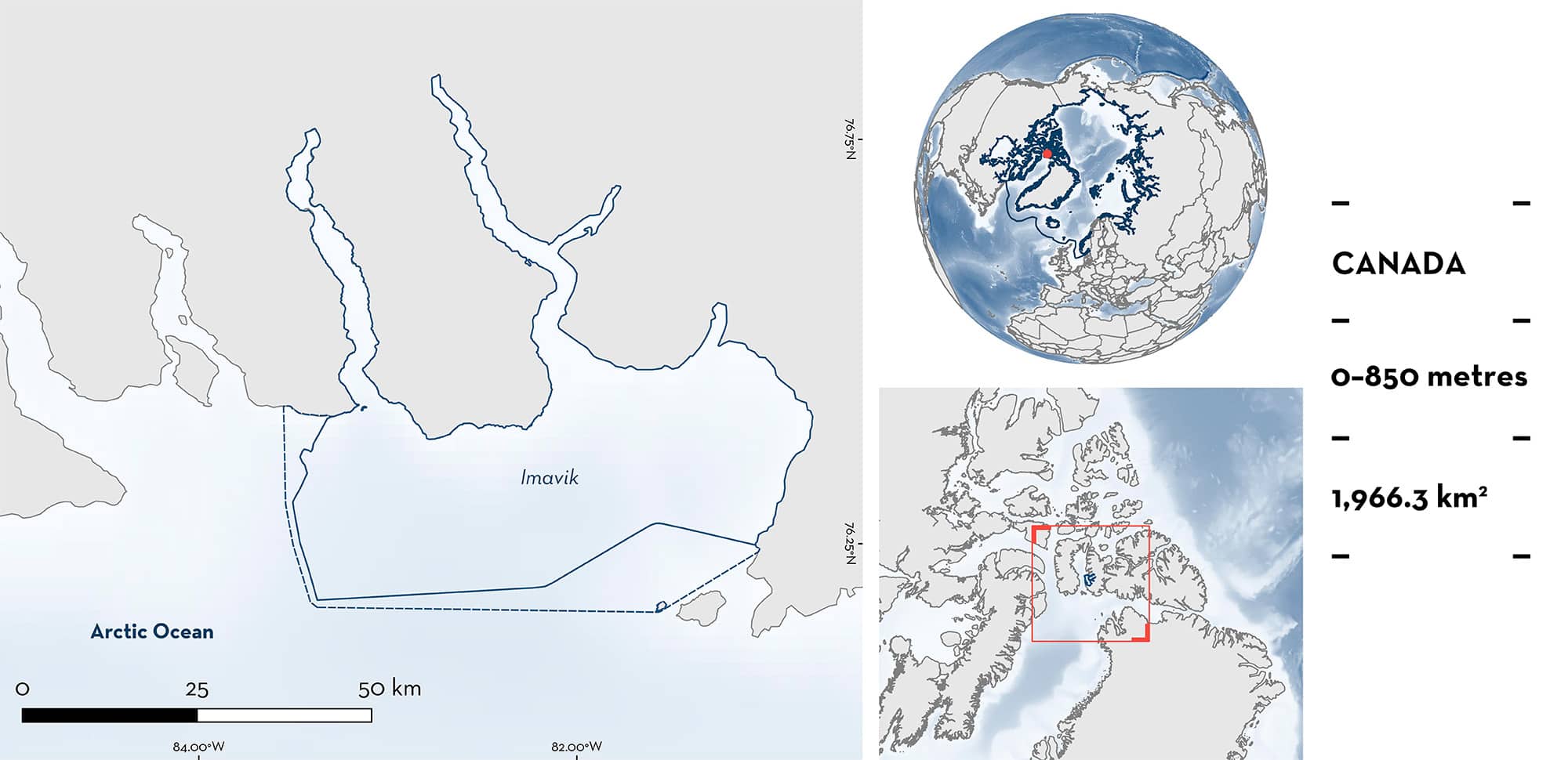ISRA FACTSHEETS
ISRA FACTSHEETS
POLAR WATERS REGION
Imavik
Summary
Imavik is located within Jones Sound, a large waterway located in the Qikiqtaaluk region on the northern section of Baffin Island, Nunavut, Canada. Deep basin waters from the Arctic Ocean enter the area through narrow channels at its western end and circulation is counterclockwise. The benthos is mostly fine-grained sediments with sea pens. During the boreal summer months, glacial meltwater has a significant influence. Within the area there are: threatened species and undefined aggregations (Greenland Shark Somniosus microcephalus).
Download factsheet
Imavik
DESCRIPTION OF HABITAT
Imavik is located within Jones Sound, a waterway located in Nunavut, Canada. The sound extends south of Ellesmere Island and north of Devon Island. The benthos is mostly fine-grained sediments with sea pens (Umbellula encrinus) (Devine et al. 2019). Glacial meltwater significantly influences the area during the boreal summer months (July to November) (Bhatia et al. 2021).
Strong southerly currents bringing deep basin waters from the Arctic Ocean enter Jones Sound at its western end through the narrow channels of Cardigan Strait and Hell Gate and enter from northern Baffin Bay and Nares Strait at the eastern opening of the sound, with circulation generally moving counterclockwise (Wekerle et al. 2013). The deep water toward the centre of the sound, south of Grise Fiord, reaches depths of ~850 m (Devine et al. 2019).
This Important Shark and Ray Area is benthopelagic and is delineated from inshore and surface waters (0 m) to a depth of 850 m based on the depth range of Qualifying Species in the area.
CRITERION A
VULNERABILITY
One Qualifying Species considered threatened with extinction according to the IUCN Red List of Threatened Species regularly occurs in the area. This is the Vulnerable Greenland Shark (Kulka et al. 2020).
CRITERION C
SUB-CRITERION C5 – UNDEFINED AGGREGATIONS
Imavik is an important area for undefined aggregations of one shark species.
In August 2015, five Greenland Sharks were captured within the area by five short benthic longline sets at depths of 50–200 m. Longlines were composed of 5–6 hooks soaked for 12–24 hours (18.18 sharks/100 hooks; Hussey et al. 2018). These catches were higher than in adjacent areas. In 2014, exploratory fishing for Greenland Halibut Reinhardtius hippoglossoides occurred to the west of this area. A total of 21 longline sets were conducted at depths of 86–834 m. Longlines were composed of 10 tubs of gear, each tub containing ~1,050 hooks and soak time ranged from 17 to 40 hours. A total of 73 Greenland Sharks were captured (0.03 sharks/100 hooks; Wheeland et al. 2015). In 2016, three longlines were set to the south of this area, at 731–818 m and incidental catch consisted of five Greenland Sharks caught using 375 hooks and a soak time ranging from 21.25 to 29.25 hours (0.44 sharks/100 hooks; Wheeland & Devine 2016).
Between 2015–2016, a total of 31 baited remote underwater video station (BRUVS) deployments were conducted from a fishing vessel in Nunavut, 11 of which were deployed within the area in 2016 (Devine et al. 2018). Individuals were identified from the video footage using unique scar and colouration patterns and other physical characteristics. Within Imavik, 57 Greenland Sharks were recorded (total time of recording = 94.62 hrs; 0.6 sharks/hour). The maximum number of sharks in one set was 11 individuals within 9.4 hours of recording (the first 6 were recorded in less than 250 minutes). From the 11 sets within this area, two recorded two sharks in the same frame, and another six recorded two different sharks within less than 5 minutes suggesting a relatively high density of sharks. Offshore to the south of this area, four BRUVS were deployed, and eight Greenland Sharks were recorded (total recording time = 31.35 hours; 0.25 sharks/hour). Only seven of all 31 deployments within the broader Nunavut sampled area recorded eight or more sharks, and three were within this area. Considering the large geographical and depth range of Greenland Sharks, detections of such large numbers of animals in BRUVS at a static depth and within a short timeframe, suggest that Greenland Sharks aggregate in this area during the ice-free period.
Combined longline and BRUVS surveys covered a broader area of Jones Sound and both found a higher density of sharks within Imavik. More information is needed to confirm the nature and function of these aggregations.
Download factsheet
SUBMIT A REQUEST
ISRA SPATIAL LAYER REQUEST
To make a request to download the ISRA Layer in either a GIS compatible Shapefile (.shp) or Google Earth compatible Keyhole Markup Language Zipped file (.kmz) please complete the following form. We will review your request and send the download details to you. We will endeavor to send you the requested files as soon as we can. However, please note that this is not an automated process, and before requests are responded to, they undergo internal review and authorization. As such, requests normally take 5–10 working days to process.
Should you have questions about the data or process, please do not hesitate to contact us.


